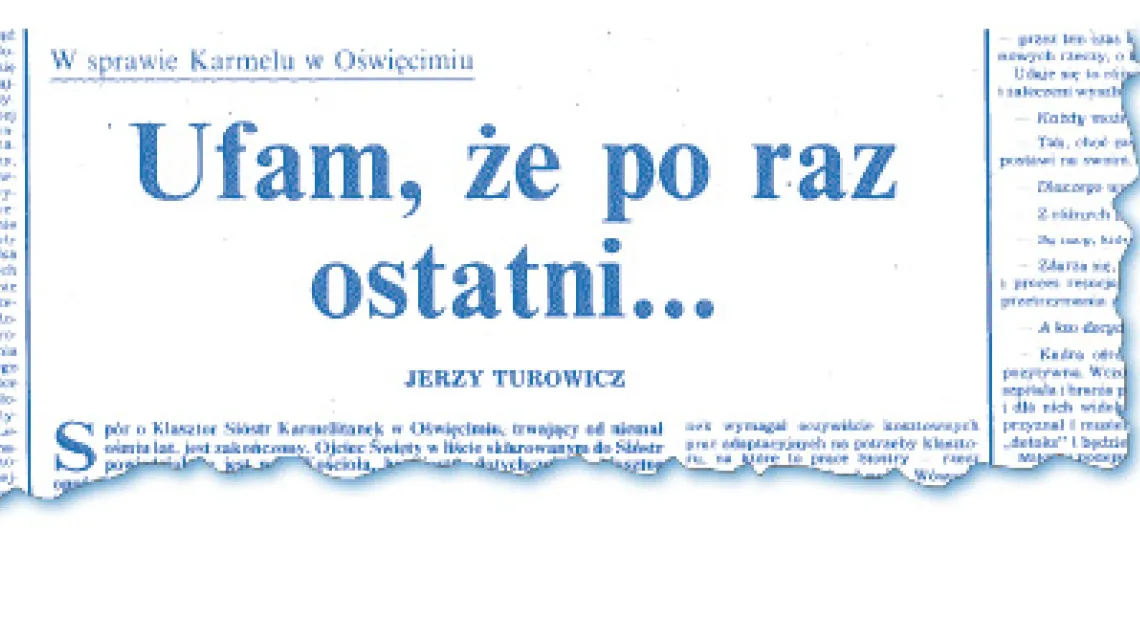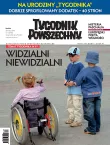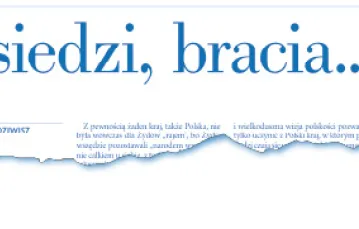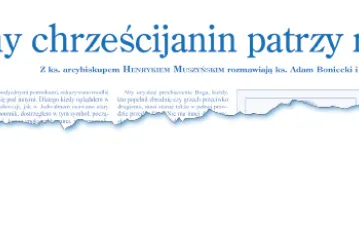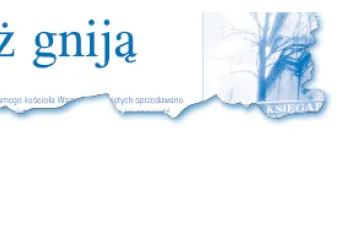Wykupienie dostępu pozwoli Ci czytać artykuły wysokiej jakości i wspierać niezależne dziennikarstwo w wymagających dla wydawców czasach. Rośnij z nami! Pełna oferta →
Jerzy Turowicz’s article appeared in Tygodnik Powszechny No. 20/93, but the conflict surrounding the Carmelite convent had also been covered earlier, and as editor-in-chief of Tygodnik, Turowicz had witnessed as well as participated in the international negotiations aimed at ending the conflict. The issue of the Carmel (house of prayer), which was established at the place that has become the symbol of the Holocaust, figured prominently in the world media (and in Tygodnik Powszechny) after an incident in July 1989 when Rabbi Avi Weiss tried to break into the convent and was forcibly removed by workmen present at the scene, and after the August sermon by Cardinal Józef Glemp at Jasna Góra (“Recently a group of seven Jews from New York attacked a convent at Auschwitz; fortunately, no nuns were killed and the convent was not destroyed because they were stopped, but one should not call the attackers heroes"); in the opinion of many observers, finding a solution that would satisfy both sides was the key to improving relations between Catholics and Jews at the time. The nuns finally moved after Pope John Paul II sent them a letter in April 1993 (“Now it is the will of the Church that you should move to another place," the Pope wrote); this, however, did not end the controversy surrounding the “Christianisation of Auschwitz" (see the text by Father Stanisław Musiał in this volume).
The conflict surrounding the Carmelite convent at Auschwitz, which lasted for nearly eight years, has ended. In his letter to the nuns, the Pope stated that it was the will of the Church that they leave the convent. Bishop Tadeusz Rakoczy, the ordinary of the diocese that includes Auschwitz, stated that the nuns would submit to the Pope’s will. It is no longer of substance whether they shall leave their convent in one month’s or in two months’ time, and whether they wish to move to a new convent built a few hundred metres from the camp or elect to move somewhere else, as is their sacred right to do.
Shortly before the Holy Father’s letter was published, the conflict had escalated rapidly. It was not clear whether the commitment to move the convent, which had been made at Geneva, would be honoured, and failure to honour it could seriously disrupt the celebrations of the 50th anniversary of the Warsaw Ghetto Uprising. Many, often contradictory, news items and comments emerged as to who had the authority to decide on the matter. This confused the general public even more, which had not been well informed about the conflict.
One suspects that some sections of Polish society are dissatisfied
with the Holy See’s decision, believing that it is unfair to the nuns and amounts to a “capitulation" to Jewish demands. Even more people simply do not understand this decision. Admittedly, many books have been written (in various languages) about the dispute over the convent at Auschwitz, and not hundreds but thousands of articles have been published, also in Tygodnik Powszechny; the Znak monthly (No. 4-5/1990), and the Polish edition of L’Osservatore Romano carried an exhaustive dossier of the case. Nevertheless, it is perhaps worth it - for the last time, I hope - to remind everyone why Jews demanded that the convent be moved, why the understanding was concluded, what it meant, and what the inevitable consequences of it were.
The Conflict Revisited
Let us briefly recall the history of the dispute once again. In 1984, at the Carmelite nuns’ request, the state authorities allowed a convent to be established in the so-called old theatre building just outside the Auschwitz camp, close to the Wall of Death. In accordance with the vocation of their contemplative order, the nuns wished to pray at the site of this terrible crime - for its victims as well as its perpetrators.
The “old theatre" building, which was constructed by the Austrian authorities before the First World War as a theatre for soldiers (the site where the concentration camp was later established use to house military barracks), never served its original function. During the Nazi occupation, it was a warehouse for the deadly Zyklon B gas used to kill Jews, and after the war it became a municipal cooperative warehouse. Obviously, the building required costly renovation in order to be converted into a convent, and the nuns simply did not have the necessary funds. During the Pope’s visit to Belgium in 1985, the Kirche in Not [Church in Need] organisation from the Federal Republic of Germany, which extended considerable material assistance to Churches in Central and East European countries, and particularly to contemplative congregations, appealed for funds to be raised for the Auschwitz convent as a gift to the Pope. The appeal, which was worded in quite a clumsy and triumphalist manner and failed to mention that Auschwitz was a Holocaust site, made the Jewish public aware of the existence of the convent. Jews saw the appeal as an attempt on the part of the Catholic Church to “appropriate" the camp or even to proselytise, i.e., convert Jews to Christianity. (The text of the Church in Need appeal and other documents referred to here can be found in the special edition of the Znak monthly mentioned above).
News of the convent’s location drew vehement protests from Jewish communities in the West, especially in Belgium and France; Jewish organisations petitioned the Catholic Church authorities and initiated a press campaign. Since the campaign was extremely injurious to the Church, two meetings between representatives of the Church and the Jewish community were held in Geneva in 1986 and 1987 at the initiative of three cardinals from France and Belgium in order to defuse the conflict. The Catholic side was represented by Cardinal Macharski as the bishop ordinary of the archdiocese in which Auschwitz was located, Cardinal Decourtray from Lyon, Chairman of the French Episcopate and Archbishop of Paris Cardinal Lustiger, and Chairman of the Belgian Episcopate Cardinal Danneels. Also present as advisers to Cardinal Macharski were Father Stanisław Musiał SJ, and the author. The Jewish delegation included leading representatives of secular and religious Jewish organisations from Western Europe.
The first meeting, which took place in July 1986 and whose purpose was to clarify the position of each side, concluded with the adoption of the joint “Auschwitz Declaration" entitled “Zakhor - Remember!" The declaration stated that “the sites of Auschwitz and Birkenau are recognised today as symbols of the Final Solution, under which the Nazis carried out the extermination of six million Jews, one and a half million of whom were children, simply because they were Jews. They died abandoned by an indifferent world." It was also decided that the talks would continue in order to resolve the conflict definitively. As a result, in February 1987, a second meeting took place, which involved more participants from both sides. On the Catholic side, the present ordinary of the Rzeszów diocese Bishop Kazimierz Górny (auxiliary bishop of the Kraków archdiocese at the time) joined Fathers Dupuy and Dujardin - members of the French Episcopate Committee for Dialogue with Judaism. As a result of the discussions conducted during that meeting, a second joint declaration was adopted, stating that a “centre for information, education, meeting, and prayer" would be established outside the perimeter of the camp. According to the declaration, the establishment of the centre “implies that the Carmelite nuns’ initiative of prayer will find its place, confirmation, and true meaning in this new context, and also that due account has been taken of the legitimate sentiments expressed by the Jewish delegation. There will, therefore, be no permanent Catholic place of worship on the site of the Auschwitz and Birkenau camps."
The declaration did not expressly state that the convent would be moved to another location - Cardinal Macharski, who had come up with the idea for the centre, could not make this commitment without the knowledge and consent of the Carmelite nuns and the authorities of their order. However, it was clear to all the participants that the Geneva declaration constituted an understanding on the basis of which a convent would be constructed within the framework of the future centre, to which the Carmelite nuns would move from the “old theatre" building they had hitherto occupied. It should be added that it was decided that Western Churches would contribute financially to the construction of the centre and that the project would be completed within two years of the date on which the declaration was adopted, i.e., 22 February 1987. Incidentally, the Jewish side pressed for a much shorter deadline and it was Cardinal Lustiger who convinced the Jewish partners that for a Church operating in a communist country, faster implementation of the project was not possible.
In practice, the two-year deadline proved completely unrealistic as well. For various reasons - more of which later - the implementation of the Geneva understanding was greatly delayed and construction of the centre did not begin until 19 February 1990, i.e., a year after the date originally set for its completion. This long delay and another failure to meet the agreed deadlines inevitably provoked an unfavourable reaction on the part of the Jewish community, which questioned the good will and credibility of the Catholic side. The international press campaign regarding the convent continued and, in Auschwitz itself, hostile demonstrations by various Jewish groups took place, including the well-known incident involving Rabbi Weiss. It should be noted here, however, that most Jews considered Rabbi Weiss irresponsible and a maverick; the more moderate and responsible Jewish organisations tried to prevent such displays of hostility.
At the same time, news of the conflict and of the Geneva understanding triggered negative responses from the Polish Catholic community as well, particularly from the residents of Oświęcim, the more so as it was known that the nuns themselves were reluctant to leave the “old theatre."
Jewish Arguments
Let us, however, try to answer one basic question: why did Jews demand that the convent be moved and to what extent were their demands justified? In fact, there is a fundamental difference between the Christian and Jewish religious traditions. For Christians, a place such as Auschwitz is a site sanctified with the blood of martyrs, who included all the victims of the camp irrespective of their nationality or creed. Thus, it is only natural for Christians that the Auschwitz site should be a place of prayer. For Jews, on the other hand, it is a cursed site, a place where “God was silent" while Jews were being murdered. Therefore, their position is that the site should remain silent and no permanent temples or structures serving religious purposes should be erected there, just as in all Jewish cemeteries.
(A counter argument sometimes raised by the Polish side is that a Carmelite convent and a Jewish house of prayer stand at the site of the former Dachau concentration camp. This is true, but Dachau was not a Holocaust site and is not a Jewish cemetery).
Another cause for Jewish concerns is more important here, however: it is the conviction that the location of the convent testifies to the Catholic Church’s intention to “appropriate" the camp and to “Christianise" and “dejudaise" it; in short, it is an attempt to obliterate the memory of the fact that Auschwitz is primarily a Holocaust site. This belief is wrong in the sense that neither the Catholic Church nor the Carmelite nuns had such an intention. However, although the presence of the convent is not an expression of an intention to “appropriate" the camp, it does reflect a certain disregard for Jewish rights to Auschwitz. Indeed, when it was decided to establish a Carmelite convent close to the camp, no one thought this could be a problem at all.
What are the grounds for Jewish “rights" to Auschwitz? First, the role that the extermination of Jews (decreed by Hitler and largely implemented) plays in the Jewish consciousness, both in Israel and in the diaspora, needs to be explained - or recalled - here. This terrible crime, the premeditated murder of an entire nation, the “final solution" of the so-called Jewish problem by “industrial" means, was nearly achieved within all the territories subject to Nazi rule. Half of the entire Jewish nation perished. For Jews, the history of their nation is divided into the pre-Holocaust and post-Holocaust periods.
Auschwitz - the Symbol that Divides
For Jews, the symbol of the Holocaust is Auschwitz where one and a half million Jews were killed. It could be argued that it was Birkenau, and not Auschwitz, that was the extermination site, but this is just sophistry. In the final analysis, Auschwitz was a single huge camp complex that encompassed Birkenau as well. It could be argued that Jews died not only at Auschwitz, but also at Treblinka, Sobibór, Majdanek, and Bełżec. This is all true, but at the same time inconsequential, since Auschwitz is a symbol of extermination (Holocaust, Shoah) not only for Jews and its name is known all over the world in this context.
Jews sometimes behave as if they had exclusive rights to Auschwitz; obviously, they do not. Konzentrationslager Auschwitz was established in May 1940; the extermination of Jews at Birkenau began nearly two years later. Before that time and until it was liberated in January 1945, Auschwitz served as a concentration/labour camp where hundreds of thousands of people (mainly Polish Gentiles) died; although many survived
the camp, in the consciousness of Poles Auschwitz is also a symbol of the martyrdom of the Polish nation and this is without doubt entirely justified. Both symbols, which stand for the two nations’ common suffering, should be a unifying force. Unfortunately, the opposite is the case. Jews, especially those who lived outside Europe during the war years, are often unaware, or unwilling to accept, that Auschwitz was not just a place where Jews were exterminated; they want exclusive rights, so to speak.
On the other hand, Poles are not always aware of the true proportions, either. The communist authorities, which ran the museum at the Auschwitz site, effaced the memory of the Holocaust quite effectively. Nowadays, Poles sometimes equate the fate of the Poles and the Jews under the Nazi occupation by saying, “we were also killed, we would be next in line after the Jews." Well, this is both truth and untruth. It is true that we were killed too, but the fate of the Jews was - dare I say it - a hundred times worse than that of the Poles. Nobel Laureate Elie Wiesel, who was an Auschwitz inmate as a child, once said, “Not all victims were Jews, but all Jews were victims." The Jews’ fate differed from that of the Poles both quantitatively and qualitatively. In quantitative terms, the number of Jews killed at Auschwitz was ten times that of Poles, and, in the country as a whole, the Nazis murdered more than 90 percent of Jews, while among Polish Gentiles, 10 percent perished during the Second World War - not just at the hands of the Nazis but in the Soviet Union and on all fronts of the war as well. In qualitative terms, each Jew who was incarcerated in any of the ghettos anywhere in the country was condemned to death and this sentence was carried out, while the chances of a Jew surviving outside the ghetto were minimal. There is no clear proof, on the other hand, that the Poles were to suffer the same fate as the Jews, although we would certainly experience great hardship, the extermination of elites, and the transformation of the remaining population into a slave labour force.
In short, a Pole who was transported to Auschwitz stood a chance of getting out alive, although not everyone did survive in the end. A Jew who was brought to the Birkenau ramp had no such chance. Therefore, equating the fate of Jews and Poles must be seen by the former as an intentional or unintentional attempt to diminish the tragedy of the Jewish nation. Both the Jews and the Poles (and other nations as well, particularly the Roma, whose fate was similar to that of the Jews) have a right to Auschwitz, but Jews have the greatest right. Although one person death is equal to another person death regardless of their ethnic origin, Auschwitz as a symbol of the Holocaust takes priority over Auschwitz as a symbol of the martyrdom of the Polish nation.
What does all this have to do with the Carmel at Auschwitz? Well, it explains the particular sensitivity of Jews to everything that concerns the former camp, and particularly to their foremost “right to Auschwitz" being questioned, which - in their opinion - leads to the memory of the camp being “dejudaised."
Fear of the “Christianisation" of Auschwitz
Jewish fears concerning the “Christianisation" of Auschwitz, i.e., the appropriation of the camp and its symbols by Catholics, are no less important, however. This mistrust has its roots in the thousand-year-old relationship between the Jews and the Catholic Church. The history of this relationship should not be oversimplified, since it included good moments and periods, but it is a fact that the Catholic Church (or, more properly, Christian Churches, because neither the Orthodox nor the Protestant Churches are blameless here) bears a significant share of responsibility for the anti-Semitism that has persisted with varying intensity to the present day. Although anti-Semitism is older than Christianity and its causes were (and are) many, it is a fact that some Fathers of the Church were rabid anti-Semites; that councils and synods adopted decrees directed against Jews; that religiously motivated massacres and pogroms occurred, particularly during the Crusades; that the Inquisition persecuted Jews who were forcibly converted and groundlessly accused of deicide, ritual murders or desecrating the host - what is called the teaching of contempt continued for centuries.
It was only in recent times, after the war and the Holocaust, that the Second Vatican Council thoroughly revised the Church’s attitude towards the Jews, stating that neither Jews who lived at the time of Christ nor their descendants could be held responsible for “deicide"; that the Jewish nation that had once been chosen by God never ceased to be the chosen nation since God never revoked that choice; that Judaism and Christianity were closely related since they shared the Old Testament and a common faith in the same God; and, finally, that anti-Semitism - resentment or hostility towards Jews just because they were Jews - was a sin and could not be reconciled with Christianity. The problem is that this quite radical change in the Church’s attitude towards the Jews and Judaism, which is expressed in many Church documents as well as in a pastoral letter of the Polish Episcopate, has not yet registered with many members of the Church in Poland and elsewhere.
Why do I mention all this in connection with the Auschwitz convent dispute? It is simply that memories of the past justify the Jews’ distrust and suspicions, their fears concerning the attempted “Christianisation" of Auschwitz and its symbolism, and their demands that the convent be located farther away from former camp grounds.
The Jewish side has also put forward another argument against the present location of the convent, although it is of secondary importance in this dispute. In 1978, upon an application by the Polish authorities, the entire former concentration camp at Auschwitz was placed on UNESCO’s World Heritage List. Pursuant to the UNESCO World Heritage Convention, no alterations are allowed within the area of the former camp. Although the “old theatre" building is just outside the perimeter, the map enclosed with the Polish application includes this building and the establishment of the convent there was thus in breach of the UNESCO Convention, of which fact the nuns and Church authorities were obviously unaware and the state authorities probably forgot. This was another reason why the Jewish side demanded that the “old theatre" building be restored to its original form. In a recent article in the Słowo - Dziennik Katolicki daily, Edward Garstka questions whether the UNESCO Convention was breached and claims that UNESCO has been silent in this matter. This is not true. The International Council on Monuments and Sites (ICOMOS), acting on behalf of UNESCO, has intervened with the Polish authorities in this matter several times, including recently. If UNESCO does not apply greater pressure, this is because it assumes that when the Geneva understanding is implemented, the problem will be resolved.
Catholics in Defence of Dialogue
We need to attempt to answer the following question: what was the position of the Catholic side during the Geneva talks and why was the understanding (since it was just an understanding, and not a formal treaty or agreement) reached? During the Geneva talks, the Catholic side tried to explain to its Jewish partners, first of all, that it had not been the Church’s intention to “appropriate" or “Christianise" Auschwitz and its symbols. Nevertheless, the Catholic side had to recognise the validity of some of the concerns expressed by their Jewish partners. Secondly, the Catholic side (both in Poland and in Western Europe) was intent on reaching a peaceful resolution to the conflict - a compromise that would be conducive to the further development of dialogue between Christians and Jews.
It must be said that the Catholic Church values this dialogue, which has become quite intense since the Second Vatican Council, and whose aim has been reconciliation with the Jewish nation, overcoming past problems and removing mutual resentment and misunderstandings, much more than its Jewish partners. The post-Council Church is aware of its responsibility for past relations between the Church and the Jews, which were incompatible with the spirit of the Gospel, and it understands the link between Judaism and Christianity better, as has already been mentioned. On the other hand, religious Jews have less need for this dialogue; they consider the Old Testament and the tradition that springs from it to be sufficient, while regarding Christianity as some sort of sect, however huge.
The conflict surrounding the Carmelite convent at Auschwitz virtually blocked all dialogue for several years. The two most important meetings within the framework of this dialogue, which has been pursued since 1970 by the Pontifical Commission for Religious Relations with the Jews and the International Jewish Committee for Interreligious Consultation, in Zurich and New York, were cancelled precisely as a result of the conflict over the Auschwitz convent. Had the conflict not been recently defused thanks to the Pope’s letter, there would have been grounds to fear that this forum for Christian-Jewish interreligious dialogue would be completely destroyed. And I would like to repeat once again: the Catholic Church is more interested in this dialogue than the Jewish side.
Finally, in the approach of the Catholic participants of the Geneva talks to the convent dispute, the awareness of the challenge that Shoah poses for the Christian conscience played a particular role. Within a few years, in the middle of Europe, an ostensibly Christian Europe, 6 million Jews were murdered. They died abandoned by an indifferent world, as the first Geneva declaration says. They died while Churches and Christians, with some exceptions, remained silent. They perished as victims of Nazi ideology, which was anti-Christian at the same time, but whose anti-Semitism was, after all, the culmination of a two-thousand-year old anti-Semitic tradition. Awareness of the challenge to which Auschwitz is a silent witness must have made the participants of the Geneva talks particularly sensitive to Jewish anxieties and concerns.
Understanding and Delay
For all the above reasons, the Catholic delegation to the Geneva talks (I will discuss the nature of this delegation shortly), recognising that the Jewish side’s demands were partly justified and trying to salvage Christian-Jewish dialogue as well as being aware of the delicate nature of the problem and the possible negative responses in Poland, decided to put forward a proposal, formulated by Cardinal Macharski, that a centre for information, education, meeting and prayer be constructed and that the convent be moved to that centre. It must be added here that the Western members of the Catholic delegation to the Geneva talks did not consider the proposal to move the convent a “capitulation" to Jewish demands; they might have underestimated Polish sensitivity. They said that, in their opinion, it would not make any difference whether the nuns prayed next to the perimeter fence or several hundred metres away, particularly where the interest of the Church demanded that the convent be moved. It was decided that, under the circumstances, there was no alternative but to move the convent. And it was by no means certain whether the Jewish side would be satisfied by this solution.
Fortunately, following a long discussion, the Jewish side accepted Cardinal Macharski’s proposal, but its implementation, as has already been mentioned, was significantly delayed and meeting the two-year deadline proved impossible for various reasons. Drawing up the architectural design for the centre, deciding on its location, obtaining the permission from the state authorities, buying the land and, finally, collecting funds, took a lot of time. Although cardinals from France and Belgium, later joined by Churches from Germany and the US as well as the Vatican, promised to participate in the construction of the centre, the funds are flowing in slowly and the costs have exceeded original estimates.
There were, however, other causes for the delay in the implementation of the Geneva understanding. One of these was the reluctance on the part of the nuns as well as a sizeable section of Polish society to accept the solution agreed in Geneva, which was manifested in various ways, including in the press. I am afraid that some responsibility for this state of affairs lies with our Church authorities, which never informed the public sufficiently clearly and unambiguously as to why the Jews had demanded that the convent be moved, why an understanding had been concluded, what it meant, what its consequences were, and why it was in the Church’s interest to honour those commitments.
Another difficulty was the persistent confusion as to who should make the decisions with respect to implementation of the Geneva understanding: the local Church authorities (i.e., the bishop ordinary of the diocese), the authorities of the Carmelite Order, the Vatican Congregation for Institutes of Consecrated Life and Societies of Apostolic Life acting on behalf of the Holy See or, finally, the nuns themselves? The matter had to be resolved in accordance with the provisions of Canon Law, but the particular instances were quick to shirk responsibility due to the delicacy of the matter. The Vatican Congregation, which had the required competences, preferred the problem to be resolved by the Carmelite authorities. The central authorities of the Carmelite Order in Rome wanted the issue to be decided by the local Carmelite authorities in Poland. And the local Carmelite authorities, who apparently did not grasp the interest of the universal Church at stake, were reluctant to implement the Geneva understanding. Finally, as we know, a personal intervention by the Pope was required to end the conflict over the convent.
A few things remain to be explained. Opponents of the Geneva understanding have claimed time and again that it was not the entire Jewish community but just its extreme wings that opposed the presence of the Carmel at Auschwitz. Articles by Dr Józef Lichten and Dr Stanisław Krajewski that had been published in Tygodnik Powszechny were cited; their authors claimed that they had nothing against the nuns’ presence and prayer. The matter is not that simple, though. In Geneva, the Jewish side was represented by the leading lights of international Jewish organisations, both secular and religious. Their position on the Carmel was supported to various degrees by practically the entire Jewish community in Israel and in the diaspora. Dr. Lichten, who was a great friend of Poland and the Church, passed away, and in a recent article in Gazeta Wyborcza (16 February 1993), Dr Krajewski - while not contradicting his earlier position and not opposing the convent - wrote,
“At the same time, I have always fully shared the anxieties and concerns underlying the Jewish protests."
The second issue is whether the Catholic delegation to the Geneva talks was representative and competent. As it clearly follows from the history of the dispute presented above, there was in fact no “formal" delegation selected by anyone (or by its members themselves!). The three cardinals from France and Belgium, motivated by their concern for the interest of the Church, which was ill served by the Carmel campaign, invited Cardinal Macharski to participate in the talks aimed at ending the dispute that concerned his diocese. Cardinal Macharski accepted the invitation and, in turn, invited Father Stanisław Musiał SJ and myself because we both were (and are) members of the Polish Episcopate’s Committee for Dialogue with Judaism and because he did not want to be alone during the difficult Geneva talks. Nevertheless, Father Musiał and I never considered ourselves to be negotiators of equal status to the four cardinals; we were just advisers to the Cardinal of Kraków. I would like to stress this fact because in his book on the convent dispute (which I wrote about in Tygodnik Powszechny), Peter Raina groundlessly ascribes to me the entire responsibility for the Geneva understanding. Well, I make no secret of the fact that I was, and am, convinced that this understanding is the right choice, but I cannot consider myself to be its author. When the final declaration was to be signed during the second meeting, I asked Cardinal Macharski whether I should sign it as well, because - I repeat - I did not consider myself to be one of the negotiators.
And the issue of competences? Well, four cardinals met prominent representatives of the Jewish community to present their respective positions, remove any misunderstandings, and look for solutions that would enable the conflict, which was very harmful to the Church, to be resolved. When it turned out that there was no solution other than moving the convent, they concluded an informal understanding. This was just an understanding and not a treaty or agreement, since they were indeed not competent to make any binding decisions on moving the convent.
The understanding was concluded in the hope that it would be ratified by competent authorities. Indeed, as a result of the difficult efforts undertaken by the Archbishop of Kraków, the Geneva understanding was approved by all interested parties: the Polish Episcopate, the authorities of the Carmelite Order, and the Holy See. The hardest part was to persuade the Carmelite nuns whom the decision concerned. This is surprising when we consider that nuns enter a convent in order to serve Christ and his Church and take an oath of obedience to their order’s authorities - just as surprising as the recent claim that it was up to the nuns to decide whether they would leave the convent or not. Their behaviour can be justified to some extent, however; first, they had the best of intentions and were very much attached to the idea of praying for the victims at the site of the crime; second, no one apparently explained to them in a persuasive enough manner that, for the good of the Church, it was necessary for them to leave the convent; third, they were supported in their resistance by a sizeable section of society, including many priests and even some bishops. Fortunately, the Pope’s words finally overcame their resistance.
As a postscript, I would like to say a few words - pro domo mea, but not only. A few days ago, an article by Edward Garstka entitled “Bias and Accuracy" appeared in the Słowo - Dziennik Katolicki daily. The subtitle was “The dispute over the convent at Auschwitz through the eyes of Jerzy Turowicz." This article (which I mentioned above) was a polemical response to my text about Peter Raina’s book on the conflict surrounding the convent. The author is opposed to the Geneva understanding and makes many incorrect claims and insinuations about me. We intended to print a response by Father Stanisław Musiał in Tygodnik Powszechny, but owing to the tensions surrounding the convent and the lack of clarity as to how the crisis would be resolved, we decided not to. Of course, now that the conflict is over, publishing the response would be pointless, so I will limit myself to stating that Mr Garstka’s article (published in a daily which purports to be an organ of the Polish Catholic Church), which concerns a delicate and controversial matter and whose purpose is to challenge the solution ultimately adopted by all Church institutions by providing arguments to its opponents, is clearly harmful to the Church.

